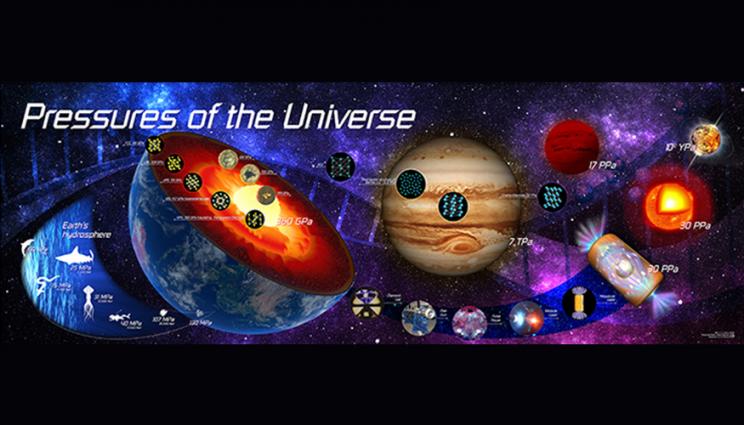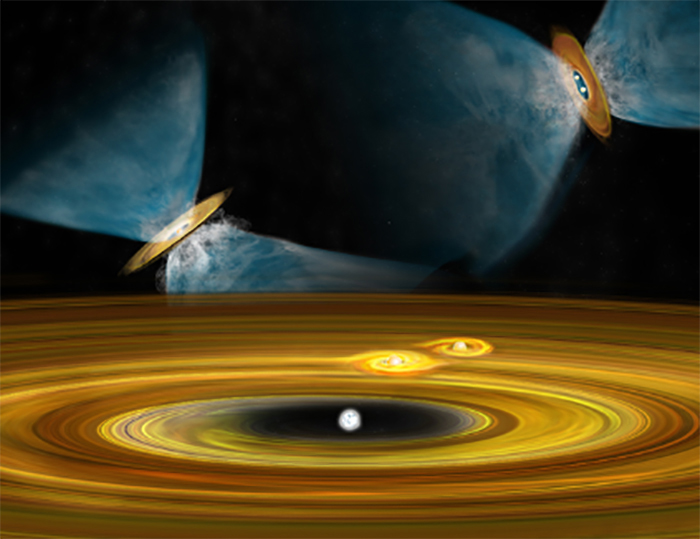
Lawrence Livermore scientists are part of a new National Science Foundation center to probe the properties of atoms under the extreme pressures found in stars, giant planets like Jupiter and super-Earths. Credit: Brian Chavez/LLNL.
High energy density (HED) scientists at Lawrence Livermore National Laboratory (LLNL) have helped launch a new National Science Foundation (NSF) effort to understand the physical and astrophysical properties of matter under pressures strong enough to change the structure of individual atoms.
The Center for Matter at Atomic Pressures (CMAP) is hosted by the University of Rochester in collaboration with researchers from LLNL's Joint High Energy Density Science (JHEDS) organization, a joint venture between the Physical and Life Sciences and National Ignition Facility & Photon Science directorates.
Researchers from MIT, Princeton, UC Berkeley, UC Davis and the University of Buffalo also are collaborating with the CMAP, a new NSF Physics Frontier Center funded by the NSF to enable transformational advances in the most promising research areas.
While past efforts have aimed at exploring pressures approaching those found in the Earth's core, CMAP seeks to characterize the properties of matter under the uncharted and extreme conditions of most of the known matter in the universe. Those properties control the evolution of planets and stars but had been inaccessible to experiments and theoretical techniques until recent scientific advancements at facilities like NIF, the world's highest-energy laser.
"This is the first NSF center aiming beyond the Earth's center and into the interiors of giant planets, super-Earths and (other) exoplanets," said LLNL physicist Jon Eggert, leader of the Dynamic Materials Properties group. "CMAP will open a whole new field of HED science to academic research."
Eggert and fellow LLNL physicists Peter Celliers and Rick Kraus are among the senior investigators for CMAP. The principal investigator is University of Rochester professor Gilbert "Rip" Collins, a former LLNL researcher.
"This is the first major initiative from NSF in the field of high energy density science," said Collins, Tracy/Hyde professor of mechanical engineering and physics and astronomy and associate director of science, technology and academics at Rochester's Laboratory for Laser Energetics. "This effort will help discover the nature of planets and stars throughout the universe, as well as the potential for new revolutionary states of matter here on Earth."
Under a five-year cooperative agreement, the NSF is providing $12.96 million in funding to the university-based centers for CMAP. LLNL will not receive NSF funding, but CMAP will provide the Lab with key opportunities to further collaborate with the HED physics academic community.
CMAP plans to exploit the capabilities of a new generation of laser, pulsed-power and X-ray-beam facilities to explore the properties of matter at and beyond 29 terapascals (TPa), the atomic unit of pressure already achievable at NIF (1 TPa is equal to 10 million Earth atmospheres).
NIF's 192 laser beams can create temperatures and pressures similar to those that exist in the cores of stars and planets and inside nuclear weapons. NIF research supports the National Nuclear Security Administration's Stockpile Stewardship Program to ensure the safety and reliability of the nation's nuclear weapons without full-scale testing.
"Atomic pressure, defined by the pressure needed to contain a hydrogen atom's energy within its atomic volume - without electrodynamic forces - dramatically reshapes the internal structure of atoms, the fundamental building blocks of all materials," Eggert said.
Many of CMAP's broad team of researchers have taken part in NIF's Discovery Science campaigns that explore new areas of basic science, including co-principal investigators Raymond Jeanloz of UC Berkeley and Sarah Stewart of UC Davis and senior investigator Tom Duffy of Princeton. They join other experts in plasma, atomic and condensed-matter physics who will try to better understand the origin, evolution and nature of thousands of recently discovered planets.
The center will lead to discoveries at the confluence of two movements in science: the discovery of thousands of potential life-sustaining planets outside our solar system, and, as Collins noted, the recent "paradigm shift in how we think about extreme states of matter." Scientists previously believed, for example, that materials subjected to very-high and atomic-scale pressures would transition to simple densely packed metals.
"However, recent theoretical and experimental results now suggest such extreme matter can become increasingly more complicated, with extraordinarily exotic properties," Collins said. Aluminum, for example, may transform from a simple metal to a transparent insulator, and hydrogen from a gas into a superconducting superfluid (see "NIF Reveals How Hydrogen Becomes Metallic in Giant Planets").
The center will concentrate on four main areas of fundamental research:
- How hydrogen and helium behave at extraordinary densities in the so-called "gas giant" planets, including Jupiter and Saturn in our own solar system. "This plays a key role in our understanding of how our solar system evolved," Collins said.
- How other elements react at high densities, to understand the nature of terrestrial and water worlds in the universe and how materials might be manipulated in laboratories on Earth to "harness revolutionary properties."
- The pathways of energy transport that enable the dramatic change in properties of material at high densities. This could shed light on topics ranging from the structure and evolution of planets and stars to refining inertial confinement fusion.
- The direct astrophysical implications of extreme matter properties, linking laboratory exploration of matter at atomic pressure with state-of-the-art models of astrophysical objects to better understand astronomical observations.
CMAP also plans an educational campaign including radio, video and web content focusing on HED students ranging from high school to graduate school.
Other co-principal investigators are Sara Seager of MIT and Adam Burrows of Princeton. The roster of senior investigators also includes Eva Zurek, University of Buffalo; Burkhard Militzer, UC Berkeley; and Adam Frank, Pierre-Alexandre Gordian, Eric Blackman, Ryan Rygg, Suxing Hu, Mohamed Zaghoo, Philip Nilson, Jessica Shang, Hussein Aluie and Miki Nakajima, University of Rochester.
- Benny Evangelista







